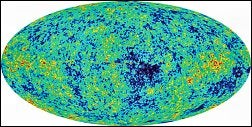Italian cosmologists reviewing the latest data from NASA’s Wilkinson Microwave Anisotropy Probe (WMAP) find they can explain some quirks by assuming the cosmic microwave background (CMB) came from a slightly football-shaped universe.
Leonardo Campanelli of the University of Ferrara and his colleagues Paolo Cea and Luigi Tedesco at the University of Bari explored an anomaly in the 3-year WMAP data. The satellite, launched in 2001, pinned down some of the universe’s most important parameters, including its age (13.7 billion years) and when the first atoms formed (380,000 years after the Big Bang). It was the formation of the first atoms that created the CMB.
Basically, the CMB appears underpowered at the largest scales. “[I]f this discrepancy turns out to have a cosmological origin, then it could have far reaching consequences for our understanding of the universe, and in particular for the standard inflationary picture,” Campanelli’s team writes in the September 29 Physical Review Letters.
Cosmologists implicitly assume the universe’s underlying geometry is spherical. But Campanelli’s group finds the WMAP anomaly goes away if, when the CMB formed, the universe — at least the part we see — was about 1 percent out of round. The result is a football-like shape called an ellipsoid.
Campanelli’s team speculates on what could have forced the universe out of spherical symmetry. A slight cosmic magnetic field — about a billionth as strong as Earth’s — could do the job. Moreover, the scientists write, this is about the right strength “to account for the observed magnetic fields in galaxies and galaxy clusters.”










